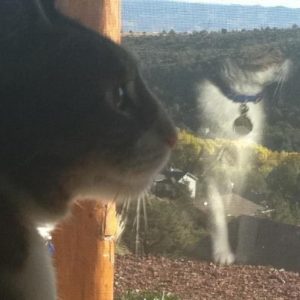 Although many of us think our dog is clever enough to understand us, this confidence has never been tested by science – until now.
Although many of us think our dog is clever enough to understand us, this confidence has never been tested by science – until now.
A new UK study found that dogs are more likely to steal food when they think you’re not looking, suggesting they understand our viewpoint.
Dr. Juliane Kaminski of the University of Portsmouth’s department of psychology found that when a human forbids a dog from taking food, the dog is four times more likely to disobey in a dark room than a lit room, signifying dogs may take into account what humans can or cannot see.
The results have scientists questioning whether dogs have a cognizant understanding of other species’ minds, an ability assumed limited only to humans.
The research published in the journal Animal Cognition and funded by the Max Planck Society involved a series of experiments. In each test, a dog was forbidden by a human from taking food. When the room was dark, the dogs took more food and took it more quickly than when the room was lit.
The tests were complex involving many variables to rule out the possibility that dogs were basing their decisions on simple associative rules, for example, that dark means food.
In total, 42 female and 42 male domestic dogs aged one year or older took part in the tests. They were chosen only if they were comfortable without their owners in the room, even in complete darkness, and if they were interested in food.
“The findings suggest that dogs are deciding that it’s safer to steal the food when the room is dark because they understand something of the human’s perspective,” Kaminski said.
She added that more research is needed to understand what is influencing the dogs’ behavior because it was thought that a dog’s understanding is limited to the “here and now.”
Another study on dog smarts conducted by Dr. Dominique Autier-Derian from the National Veterinary School in Lyon, France, found that dogs recognize their own species among other species on a computer screen. Dogs picked faces of other dogs, irrespective of breed, among human and other domestic and wild animal faces and even grouped them into categories.
Autier-Derian studied this phenomenon among domestic dogs, which have the largest morphological variety among all animal species, with more than 400 registered dog breeds.
The study explored whether this large morphological diversity presented a cognitive challenge to dogs trying to recognize their own species while confronted with other species using visual cues alone.
On a computer screen, the researcher showed nine pet dogs pictures of faces from various dog breeds and cross-breeds and, simultaneously, faces of other animal species, including human faces.
The results found dogs can form a visual category of dog faces and group pictures of very different dogs into a single category, despite the diversity in dog breeds. In fact, all nine dogs were able to group all the images of dogs within the same category.
Here is the news flash: The research concluded that dogs learned to recognize their own species despite the diversity of breeds to insure mating between different breeds is always possible.
This is hardly news to any animal shelter where on any given day many wonderful pure- and mixed-breed dogs are looking for that certain human face – yours – to take them home. This research also reminds us why we need to have our non-discriminating pets spayed or neutered.



